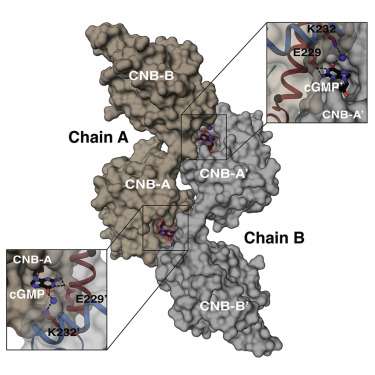Crystal structure of PKG I suggests a new activation mechanism

Protein kinases, most scientists would agree, regulate nearly every aspect of cell life. It is no surprise, then, that having faulty protein kinases may lead to a number of human conditions, including cardiovascular diseases, cancer and diabetes. Kinases form a large family. Some of its members have similar structures, which has led some researchers to propose that the activity of these kinases is probably regulated in a similar manner and, therefore, may be targeted with similar medications. In a paper published in the journal Structure, a multidisciplinary team from Baylor College of Medicine, the University of Kassel, the King Abdullah University of Science and Technology, the Lawrence Berkeley National Laboratory and the University of California, San Diego have discovered that this may not always be the case.
"Kinases add a phosphate group to other proteins and this addition is like flipping a switch; it modifies the activity of the protein," said Dr. Choel Kim, assistant professor in pharmacology and the Verna and Marrs McLean Department of Biochemistry and Molecular Biology at Baylor, and senior author of this report. "About 2 percent, or nearly 500, of all human genes are dedicated to coding protein kinases and over 50 percent of kinases are linked to various human diseases."
Kim and colleagues are interested in studying the activation mechanism of protein kinase G I (PKG I) because a mutation of PKG I has been shown to cause thoracic aortic disease, as Kim and his collaborators showed in a previous publication in The American Journal of Human Genetics.
PKG I is a large molecule. It has a regulatory (R) domain and a catalytic (C) domain. When R and C domains are together, PKG I is inactive or dormant. It does not phosphorylate other proteins. To be active, PKG I needs a small compound called cGMP, a cyclic nucleotide, to bind to the R domain, which will then free the C domain to carry on phosphorylation of other proteins. "We think that targeting the R domain might be a way to effectively regulate the activity of PKG I involved in disease because this R domain is unique for this kinase. But first we need to understand how the R domain works," said Kim.
The regulation mechanisms of PKG and PKA, a similar molecule of the same family, depend on the interaction between the R and C domains. In PKA, because the R- and C-subunits are in separate molecules, they diffuse away upon activation, preventing possible reassociation that may cause unnecessary inhibition. Unlike PKA, PKG has the R and C domains on the same molecule, which prevents them from diffusing away from each other, as in the case of PKA. Being so close to each other, on the other hand, can enhance the R-C interaction in PKG and may cause unnecessary inhibition. However, little is known about how PKG circumvents this unintended inhibition.
"To study this mechanism, we determined, for the first time, the crystal structure of the regulatory domain bound to cGMP, which is the activated form. We then compared the crystal structure of PKG I with that of PKA. In both PKA and PKG, the R domains seem to contact each other through their cyclic nucleotide binding domains. The difference between PKG I and PKA, as revealed by the crystal structure of PKG I, is that in PKG I, where the R and C domains cannot diffuse away from each other, cGMP provides critical contacts between the two R domains that may prevent R and C from getting back together. Keeping R and C separate can help sustaining kinase activity critical for relaxing smooth muscle. Our study reveals a new activation mechanism for protein kinases, which should be considered in the design of drugs that target PKG I," said Kim.
Other researchers who collaborated in this research include Jeong Joo Kim from the Department of Pharmacology at Baylor; Robin Lorenz from the Department of Biochemistry of the University of Kassel, Germany; Stefan T. Arold at the Computational Bioscience Research Center of King Abdullah University of Science and Technology in Saudi Arabia; Albert S. Reger from the Department of Pharmacology at Baylor and who is currently at Patheon Biologics-STL, St. Louis; Banumathi Sankaran from the Berkeley Center for Structural Biology, Lawrence Berkeley National Laboratory, Berkeley, California; Darren E. Casteel from the Department of Medicine, University of California, San Diego; and Friedrich W. Herberg from the Department of Biochemistry of the University of Kassel, Germany.
More information: Dong-chuan Guo, Recurrent Gain-of-Function Mutation in PRKG1 Causes Thoracic Aortic Aneurysms and Acute Aortic Dissections, The American Journal of Human Genetics, /08/2013, linkinghub.elsevier.com/retrie … ii/S0002929713002887
Crystal Structure of PKG I:cGMP Complex Reveals a cGMP-Mediated Dimeric Interface that Facilitates cGMP-Induced Activation, Cell, DOI: dx.doi.org/10.1016/j.str.2016.03.009 , www.cell.com/structure/fulltex … 0969-2126(16)00087-3
Journal information: Cell , Structure , American Journal of Human Genetics
Provided by Baylor College of Medicine

















